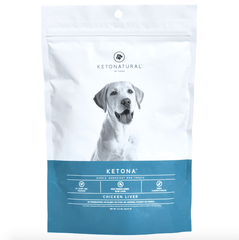Save Money, Save Your Dog.
Join Our Email List For Discounted Pricing and a Free Guide to the Science of Keto Dog Food.
If A Massive New Obesity Paper Falls Outside of JAVMA, Does it Even Make a Sound in the Veterinary Community?

Did you catch this monster paper published in the American Journal of Clinical Nutrition last month?
Led by Harvard's Dr. David Ludwig and featuring contributions from more than a dozen other nutritional science luminaries, it is a comprehensive overview of the current evidence (both for and against) the so-called "carbohydrate insulin model" of obesity (the "CIM"). It is the kind of broad, wide-ranging evaluation of a conceptual thesis that is somewhat rare in science journals, where the focus tends to be on the individual experiments that incrementally advance our understanding of narrow issues and the meta-analyses that look for trends when a single hypothesis has been tested multiple times.
Sweeping reviews like Ludwig's really only become necessary when a field is teetering on the brink of what the philosopher of science Thomas Kuhn called "paradigm shifts." Moments when the entire framework that has been accepted as gospel within a particular scientific discipline gets thrown out and replaced by something new. Think Copernican Revolution.
As I explain at length in my book (and in shorter form here), the CIM posits that the primary cause of fattening is not a simple caloric imbalance but a hormonal imbalance, one with a specific dietary cause. More particularly, the model says that the consumption of digestible carbohydrate causes the body to produce unnaturally high levels of the anabolic hormone insulin, which in turn induces body fat accumulation. In this way, dietary carbohydrate is the fundamental driver of obesity, not simple energy imbalance.
Whether or not the CIM holds water is a vital public health issue. According to the World Health Organization, obesity is a global epidemic and the fifth leading cause of death worldwide. And the assumption that caloric imbalance is the fundamental cause of the disease is baked into the vast majority of the regulatory and medical tools that public health officials have used to combat it (very unsuccessfully) over the past fifty years or so. If the CIM is valid, then all that needs to be rethought.
While readers of this blog might already be familiar with the CIM and with Ludwig's paper, I can practically guarantee that your veterinarians are not. I'm friendly with about a dozen vets and follow several dozen more on Twitter. And the only one who had any idea what I was talking about when I mentioned the Ludwig paper was Dr. Travis Einertson -- and his Twitter handle is @LowCarbVet. I have yet to see a single veterinary professional even mention the paper, either in an academic setting or otherwise.
Sadly, this is pretty typical. While most scientific disciplines operate as somewhat insular communities, veterinary nutritionists are particularly aggressive about walling themselves off from the rest of the scientific world. And, as I'll try to explain, that insularity has costs. Costs that are borne by pets and, by extension, their owners.
The silence with which the community has received David Ludwig's CIM paper is a case in point. In fact, there are two different ways that the situation underscores the sorry state of modern-day veterinary nutritional science.
First, it calls attention to how far veterinarians are lagging behind the broader nutritional science community on this important subject.
In the world of human nutrition, the past ten years have seen an enormous amount of debate over whether the CIM does or does not accurately describe the process by which human beings fatten. This issue is at the core of the so-called "diet wars," the emotionally-charged, tribalistic (and extremely online) debate over whether "all calories are created equal" or whether "carbs make you fat."
That such wars are even being fought is a testament to the cogency and persuasiveness of the body of evidence supporting the CIM. Twenty years ago almost no one in the nutritional science community had even heard of the theory. Today, if you ask Google scholar to show you peer-reviewed papers featuring the term "carbohydrate insulin model," it will return more than 380 results.
Unfortunately, none of them come from veterinary journals. And precisely zero concern the model's application to dogs or cats. The validity of the CIM has been one of if not the hottest nutritional science issue in the world over the past decade. But veterinary nutritionists haven't even spoken its name in an academic paper yet.
Note that I'm not saying the veterinary community has been too slow in adopting the theory (although I also believe that to be true). I'm saying the community hasn't even recognized that it exists. That's not just a mistake, it's an inexcusable one. Frankly, it should be embarrassing for anyone involved in the professional practice of veterinary nutritional science.
The second way that Ludwig's paper functions as a criticism of the modern-day veterinary nutrition community: it shows how poorly the community has been prioritizing its efforts over the past decade or two.
There is broad consensus among veterinarians that obesity is the single biggest public health problem facing dogs in the United States today. The disease impacts the majority of American dogs and has been shown to be deadlier for those animals than a lifetime of smoking is for human beings. No matter how you look at it, fixing America's canine obesity epidemic should be the companion animal nutritional science community's top priority.
At the same time, whether or not "carbs make dogs fat" couldn't be more important in deciding how to stop the proverbial bleeding. Although their genetic ancestors avoided carbohydrate completely for more than 99% of their evolutionary heritage, modern-day dogs consume more dietary carbohydrate than any other kind of nutrient. Carbohydrate is the most abundant nutrient in the vast majority of commercial pet food products being sold in stores today. (And, yes, that includes the pricey prescription-only diets and the fresh delivery startups.) Carbs are the backbone of the pet food industry.
What this means is that the validity of the CIM is as important an issue as presently exists in the world of veterinary nutrition. It's difficult to even come up with how any other issue could be more important. After all, it brings together (1) the most common household pet in the country, (2) the single most consequential nutrition issue that population faces, and (3) a thesis that, if correct, would demand an overhaul of $50 billion industrial food system upon which the population depends.
For some reason all that appears to be lost on the veterinary nutrition community. And I don't think I'm being unfair when I say that, fundamentally, there can really only be two explanations: bad faith or professional negligence. The complete and utter silence is just so glaring.
If you tend to agree with me, I encourage you to let the AVMA know about it. (Here's a link to the organization's comment portal.) I'd suggest you submit your comments directly to the American College of Veterinary Nutrition (the group that oversees the practice of veterinary nutritional science in the United States. But the ACVN's website does not accept unsolicited feedback from non-members.
How appropriate.

Related Articles
How Much Does The Farmer’s Dog Really Cost?
5 Signs and Symptoms That Your Dog May Have Diabetes
Learning to Take Pleasure In Being Your Dog's Play Buddy-Drill Sargeant
Dogs, Dog Food and Dogma - A Book About America's Pet Obesity Epidemic
Browse Articles By Category